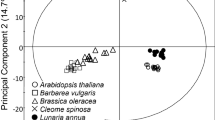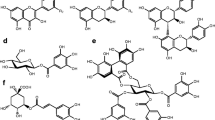Abstract
Large interspecific differences in redox potential exist among herbivorous lepidopteran larvae. Reducing conditions occur in the midguts ofManduca sexta (Sphingidae) andPolia latex (Noctuidae), whereas oxidizing conditions prevail in the midguts ofLymantria dispar (Lymantriidae),Danaus plexippus (Danaidae), andPapilio glaucus (Papilionidae). The epithelium of the posterior midgut ofM. sexta fed a diet containing bismuth subnitrate accumulates bismuth sulfide, suggesting that sulfide might be one of the reducing agents responsible for the maintenance of reducing conditions in this species. We propose that the effects of plant allelochemicals in insect herbivores will be strongly affected by gut redox conditions and that the regulation of gut redox conditions is an important adaptation of insect herbivores to the chemical defenses of plants. The redox state of the gut is yet another insect trait that must be included in the analysis of plant-insect interactions.
Similar content being viewed by others
References
Bartlett, R.J. 1986. Soil redox behavior, pp. 179–207,in D.L. Sparks (ed.). Soil Physical Chemistry. CRC Press, Boca Raton, Florida.
Bayon, C. 1980. Volatile fatty acids and methane production in relation to anaerobic carbohydrate fermentation inOryctes nasicornis larvae (Coleoptera: Scarabaeidae).J. Insect Physiol. 26:819–828.
Bernays, E.A., Chamberlain, D., andMcCarthy, P. 1980. The differential effects of ingested tannic acid on different species of Acridoidea.Entomol. Exp. Appl. 28:158–166.
Bignell, D.E. 1981. Nutrition and digestion, pp. 57–86,in W.J. Bell and K.G. Adiyodi (eds.). The American Cockroach. Chapman and Hall, London.
Bignell, D.E. 1984. Direct potentiometric determination of redox potentials of the gut contents in the termitesZootermopsis nevadensis andCubitermes severus and in three other arthropods.J. Insect Physiol. 30:169–174.
Bignell, D.E., andHeath, L.A.F. 1985. Electropositive redox state of the fifth-instar larval gut ofApis mellifera.J. Apic. Res. 24:211–213.
Bodine, J.H. 1925. Physiology of the Orthoptera. Hydrogen ion concentration of the blood and alimentary tract of certain Orthoptera (grasshoppers).Biol. Bull. 48:79–82.
Bohn, H.L., McNeal, B.L., andO'Connor, G.A. 1985. Soil Chemistry, 2nd ed. John Wiley & Sons, New York.
Breznak, J.A. 1984. Biochemical aspects of symbiosis between termites and their intestinal symbionts, pp. 173–203,in J.M. Anderson, A.D.M. Rayner and D.W.H. Walton (eds.). Invertebrate-Microbial Interactions. Cambridge University Press, Cambridge, England.
Day, M.F., andWaterhouse, D.F. 1953. The mechanism of digestion, pp. 311–330,in K.D. Roeder (ed.). Insect Physiology. John Wiley & Sons, New York.
Felton, G.W., andDuffey, S.S. 1990. Inactivation of baculovirus by quinones formed in insectdamaged plant tissues.J. Chem. Ecol. 16:1221–1236.
Felton, G.W., Donato, K., Del Vecchio, R.J., andDuffey, S.S. 1989. Activation of plant foliar oxidases by insect feeding reduces nutritive quality of foliage for noctuid herbivores.J. Chem. Ecol. 15:2667–2694.
Hurrell, R.F., Finot, P.A., andCuq, J.L. 1982. Protein-polyphenol reactions. 1. Nutritional and metabolic consequences of the reaction between oxidized caffeic acid and the lysine residues of casein.Br. J. Nutr. 47:191–211.
Keating, S.T., McCarthy, W.J., andYendol, W.G. 1989. Gypsy moth (Lymantria dispar) larval susceptibility to a baculovirus affected by selected nutrients, hydrogen ions (pH), and plant allelochemicals in artificial diets.J. Invert. Pathol. 54:165–174.
Leatham, G.F., Kino, V., andStahmann, M.A. 1980. In vitro protein polymerization by quinones or free radicals generated by plant or fungal oxidative enzymes.Phytopathology 70:1134–1140.
Lindsay, W.L. 1979. Chemical Equilibria in Soils. John Wiley & Sons, New York.
Odell, T.M., andRollinson, W. 1966. A technique for rearing the gypsy moth on an artificial diet.J. Econ. Entomol. 59:741–742.
Rowell, D.L. 1988. Flooded and poorly drained soils, pp. 899–926,in A. Wild (ed.). Russell's Soil Conditions and Plant Growth, 11th ed. Longman Scientific and Technical, Essex, England.
Smith, M.T. 1985. Quinones as mutagens, carcinogens, and anticancer agents: Introduction and overview.J. Toxicol. Environ. Health 16:665–672.
Srivastava, U.S., andSrivastava, P.D. 1956. On the hydrogen ion concentration in the alimentary canal of certain orthopteroid insects.Beitr. Entomol. 6:493–498.
Steinly, B.A., andBerenbaum, M. 1985. Histopathological effects of tannins on the midgut epithelium ofPapilio polyxenes andPieris brassicae.Entomol. Exp. Appl. 39:3–9.
Veivers, P.C., O'Brien, R.W., andSlaytor, M. 1980. The redox state of the gut of termites.J. Insect Physiol. 26:75–77.
Waterhouse, D.F. 1952a, Studies on the digestion of wool by insects. IV. Absorption and elimination of metals by lepidopterous larvae, with special reference to the clothes moth,Tineola bisseiliella.Austr. J. Sci. Res. 5B:143–168.
Waterhouse, D.F. 1952b. Studies on the digestion of wool by insects. VI. The pH and oxidationreduction potential of the alimentary canal of the clothes moth (Tineola bisselliella) (Humm.)Austr. J. Sci. Res. 5B:178–188.
Waterhouse, D.F. 1952c. Studies on the digestion of wool by insects. VII. Some features of digestion in three species of dermistid larvae and a comparison withTineola larvae.Austr. J. Sci. Res. 5B:444–459.
Waterhouse, D.F. 1953. Studies on the digestion of wool by insects. IX. Some features of digestion by chewing lice (Mallophaga) from bird and mammalian hosts.Austr. J. Sci. Res. 6B:257–275.
Yoshimura, T., Tabata, H., Nishio, M., Ide, E., Yamaoko, R., andHayashiya, K., 1988.l-Cysteine lyase of the webbing clothes moth,Tineola bisselliella.Insect Biochem. 18:771–777.
Author information
Authors and Affiliations
Rights and permissions
About this article
Cite this article
Appel, H.M., Martin, M.M. Gut redox conditions in herbivorous lepidopteran larvae. J Chem Ecol 16, 3277–3290 (1990). https://doi.org/10.1007/BF00982098
Received:
Accepted:
Issue Date:
DOI: https://doi.org/10.1007/BF00982098




